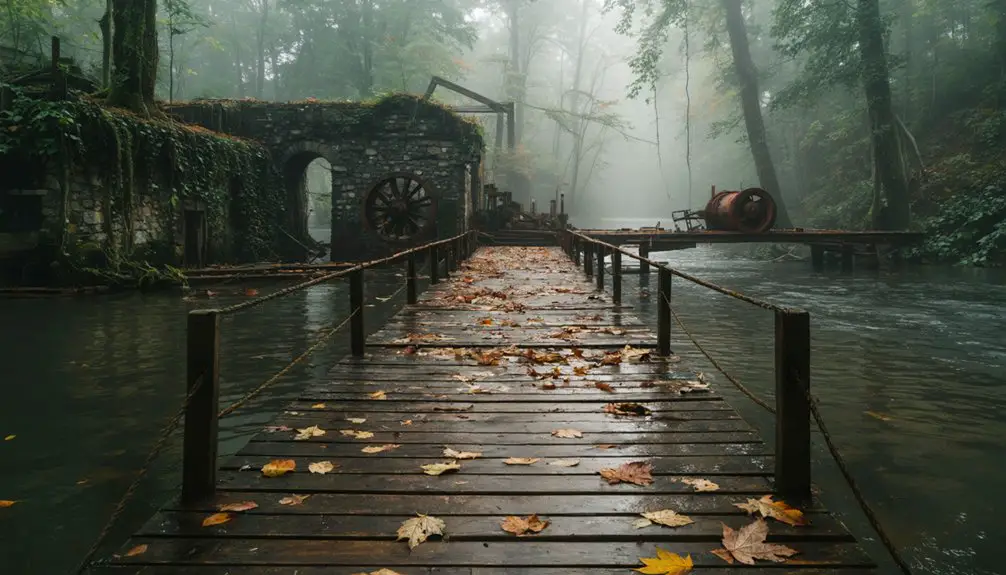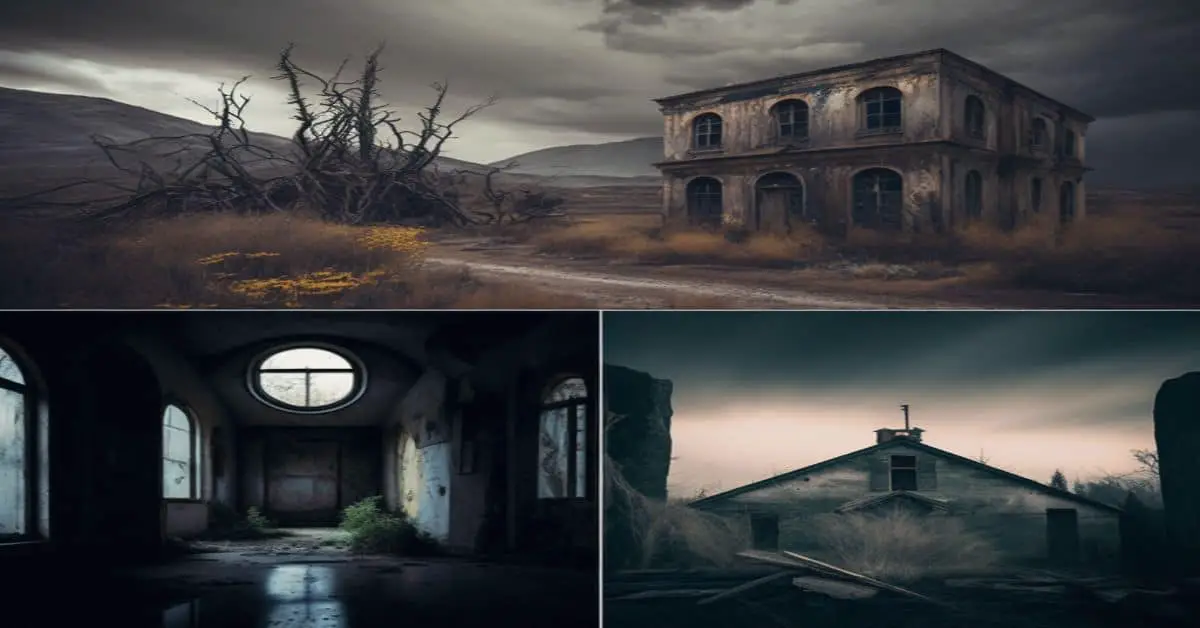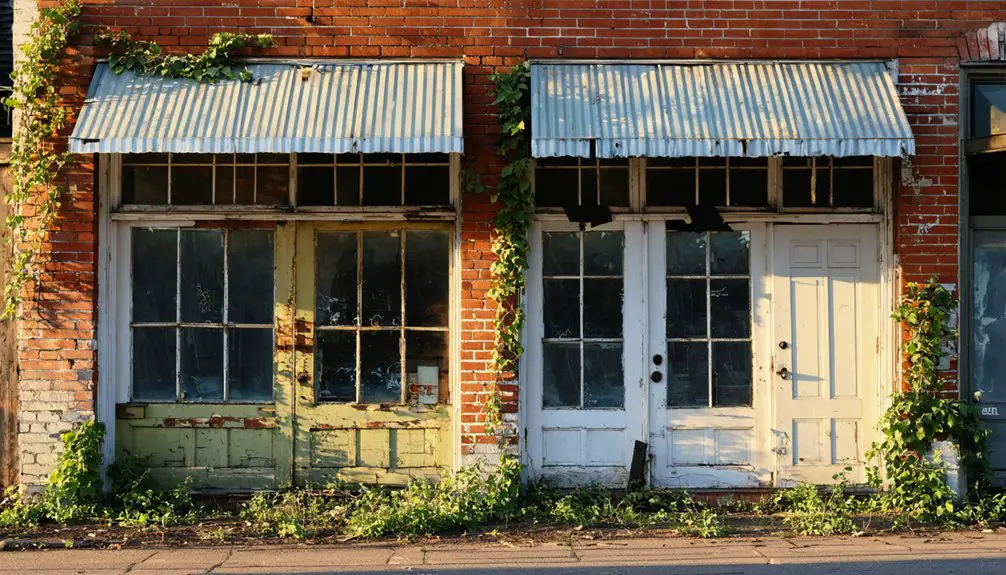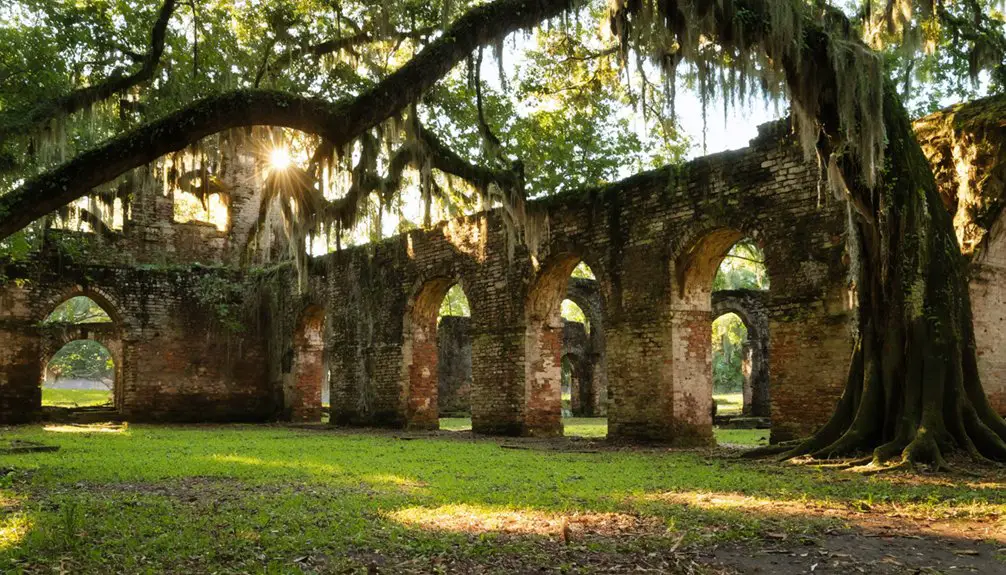You’ll find Buffalo City’s ghostly remains in northeastern North Carolina’s swamplands, where a bustling timber empire once thrived. After the Civil War, this diverse community of 3,000 residents – including African Americans and Russian immigrants – worked the region’s largest logging operation, earning wages in aluminum company currency. During Prohibition, the town reinvented itself as a moonshine hub, producing the renowned East Lake Whiskey. Today, scattered ruins and annual homecomings keep the community’s remarkable spirit alive.
Key Takeaways
- Buffalo City was once North Carolina’s largest logging town, with 3,000 residents, before becoming a ghost town in Dare County.
- Founded after the Civil War, the town thrived on harvesting swamp timber using a diverse workforce of African Americans and Russian immigrants.
- During Prohibition, the town became famous for East Lake Whiskey production, with almost every family involved in moonshine operations.
- Today, only scattered remnants remain within Alligator River National Wildlife Refuge, including rusted railroad tracks and building debris.
- The town’s memory lives on through annual homecoming events at East Lake United Methodist Church and historical preservation efforts.
The Rise of a Timber Empire
Shortly after the Civil War, the Buffalo Timber Company established what would become northeastern North Carolina’s largest logging operation on the north side of Milltail Creek.
You’d find a diverse workforce there, with African American laborers and over 200 Russian immigrants making up half the town’s population, all earning about 50 cents daily in company-issued aluminum currency.
The timber harvesting focused on the rich swampland bounty of juniper, cypress, pine, and sweet gum.
Buffalo City’s logging techniques evolved as the operation grew, with mules hauling timber to an expanding network of rail lines.
Mules dragged freshly cut logs across Buffalo City’s growing maze of railroad tracks, transforming primitive logging into an industrialized operation.
The company built worker housing, a hotel, schoolhouse, and general store, creating a self-contained community.
Despite racial segregation typical of the era, the company significantly paid Black and white workers equal wages.
At its peak, the thriving logging town reached a population of approximately 3,000 residents.
To avoid confusion with other locations, historical records often refer to this settlement as Buffalo City, NC to distinguish it from similarly named places.
Life in the Swampland Community
You’d have struggled to build a life in Buffalo City’s harsh swampland, where snakes, alligators, and swarms of yellow flies made daily tasks an ongoing battle for survival.
Despite these challenges, you would’ve found a tight-knit community where neighbors looked out for each other across racial lines, even though housing remained segregated by the railroad tracks. The town supported a bustling population of three thousand residents, making it the largest community in Dare County at the time.
Living in makeshift homes built on sawdust-filled swamp foundations, your family would’ve adapted to life without modern conveniences, relying on the town’s general store, post office, and shared resourcefulness to make it through each day. During Buffalo City’s peak years, the Buffalo Timber Company provided steady employment for both Black and white workers who received equal pay for their labor.
Daily Survival Challenges
Life in Buffalo City demanded extraordinary resilience from its inhabitants, who faced a relentless barrage of daily challenges in the unforgiving swampland.
You’d have battled intense heat and humidity while yellow flies swarmed around you, making basic outdoor tasks a test of endurance. Your survival strategies would’ve included constant vigilance against snakes and alligators lurking in the marsh, while dealing with flooding and unstable ground beneath your feet.
Without indoor plumbing or electricity, you’d have relied on community resourcefulness for basic needs.
Health hazards came from all directions – the dampness that rotted your wooden home, the dangerous logging work that paid your bills, and the isolation that made medical care nearly impossible to access.
Every day tested your will to persevere.
Communal Spirit Despite Hardships
Despite the harsh realities of swampland living, Buffalo City’s residents forged an extraordinarily tight-knit community that became their lifeline for survival.
You’d find a remarkable communal resilience that transcended the era’s typical social boundaries, with Black and white workers earning equal pay despite living in segregated areas. The town’s shared resources and collective problem-solving helped everyone weather seasonal extremes and isolation.
In the absence of formal institutions, you’d witness how neighbors developed their own moral code and informal governance, looking out for each other in ways that went beyond standard regional norms.
This spirit lives on through annual homecomings at East Lake United Methodist Church, where descendants gather to honor their unique heritage of cooperation and mutual support in the face of hardship.
Building on Swamp Foundations
The physical foundation of Buffalo City mirrored its communal strength, with residents adapting ingeniously to their swampland environment.
Swamp architecture demanded creative solutions, as you’d find buildings perched on foundations filled with sawdust and rejected timber from the mill. You’re looking at a town that turned its challenges into opportunities, using what others might’ve considered waste to create stable ground in an unstable terrain. The homes, built from unsellable lumber, provided basic shelter despite having cracks and minimal insulation.
Living in Buffalo City meant understanding these foundation challenges:
- Your home stood on waterlogged earth, reinforced with sawdust mountains to prevent sinking
- You’d build with sturdy but rough-looking rejected lumber that proved surprisingly durable
- You’d need to account for constant threats from wildlife, from snakes to bears, in your structural planning
The town’s innovative building techniques transformed an inhospitable swamp into a livable community.
Economic Foundations and Daily Work
Founded by Buffalo Timber Company in the post-Civil War era, Buffalo City emerged as a bustling logging town where cypress, juniper, and sweet gum trees formed the backbone of local industry.
You’d find workers knee-deep in swamps, battling mosquitoes and yellow flies while mastering difficult logging techniques in the marshy terrain.
Despite harsh labor struggles, the workforce – a unique mix of African Americans and Russian immigrants – showed remarkable resilience.
They’d brave alligators, snakes, and sweltering heat to earn their keep.
While housing remained segregated along the railroad tracks, workers earned equal wages regardless of race – a rare practice for the time.
The demanding work fostered a tight-knit community, with about 3,000 residents at its peak making Buffalo City the largest settlement in Dare County.
Cultural Dynamics and Social Structure
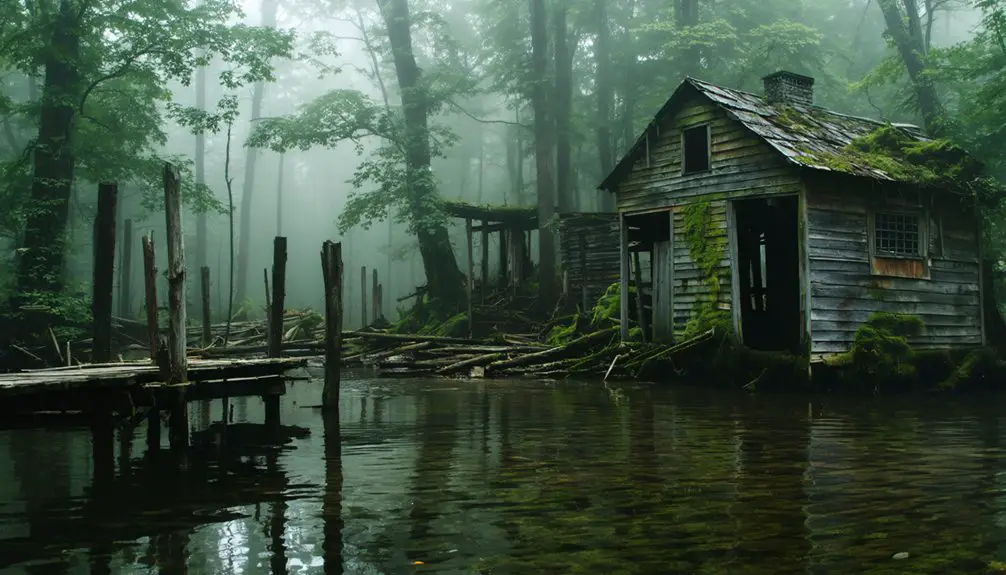
You’d find a complex social tapestry in Buffalo City, where equal wages for Black and white workers stood in stark contrast to the era’s typical Southern practices, even as housing remained segregated by the railroad tracks.
The town’s moonshine culture created unique bonds across racial lines, as both Black and white residents participated in this underground economy that helped sustain the community through difficult times.
While white workers’ red houses faced the railroad tracks and Black workers lived in homes behind them, the shared struggles of swamp life and dangerous working conditions fostered a degree of mutual dependence unusual for the segregated South.
Racial Integration at Work
While many company towns of the early 20th century enforced strict racial segregation, Buffalo City emerged as a uniquely integrated workplace where African-American laborers and Russian immigrants worked side-by-side in the logging operations.
Without formal law enforcement, the timber company officials shaped workplace dynamics through a controlled economic system using company currency.
The town’s approach to racial equity, while still imperfect, stood apart from typical employment practices of the era:
- African-American workers faced fewer restrictions on job access compared to other logging operations
- Russian immigrants and Black laborers shared common workspaces in timber processing
- The economic interdependence fostered more integrated social interactions, despite prevalent societal prejudices
This level of integration mirrored Buffalo’s pre-World War II conditions, where work rather than race determined living arrangements.
This relative integration persisted until forest depletion led to operational changes, affecting the workforce’s demographic makeup.
Social Class and Housing
The social fabric of Buffalo City took physical form in its distinctive housing arrangements, where class and racial divisions manifested in the layout of homes straddling the railroad tracks.
You’d find red-painted houses where white workers lived, while smaller white-painted homes behind them housed African-American families – a clear reflection of housing disparities of the era.
Despite these divisions, community resilience emerged through shared challenges. The town’s population of over 200 Russians added to the diverse cultural makeup of the community.
You’d see homes built from surplus timber, with sawdust foundations stabilizing the swampy ground. While the structures were well-made, they’d a rough-hewn appearance that spoke to frontier practicality.
Living conditions were basic, with no electricity or plumbing, and everyone faced the same environmental threats from alligators, insects, and harsh terrain that demanded mutual cooperation for survival.
Moonshine Culture’s Community Impact
As Buffalo City’s timber industry declined in the 1920s, moonshine production emerged as more than just an economic lifeline – it fundamentally reshaped the community’s social fabric.
You’ll find that the moonshine economy fostered a unique social order where racial barriers broke down and community resilience flourished despite harsh conditions.
- Multicultural bonds formed between African American, Russian immigrant, and white residents who earned equal wages and shared common survival needs.
- A self-enforcing moral code developed to protect moonshine operations while maintaining social stability.
- Strong family networks emerged where women managed households while supporting the clandestine trade.
This tight-knit community spirit lives on through annual reunions at East Lake United Methodist Church, where descendants gather to honor their shared heritage of independence and mutual support.
The Moonshine Era and Underground Trade
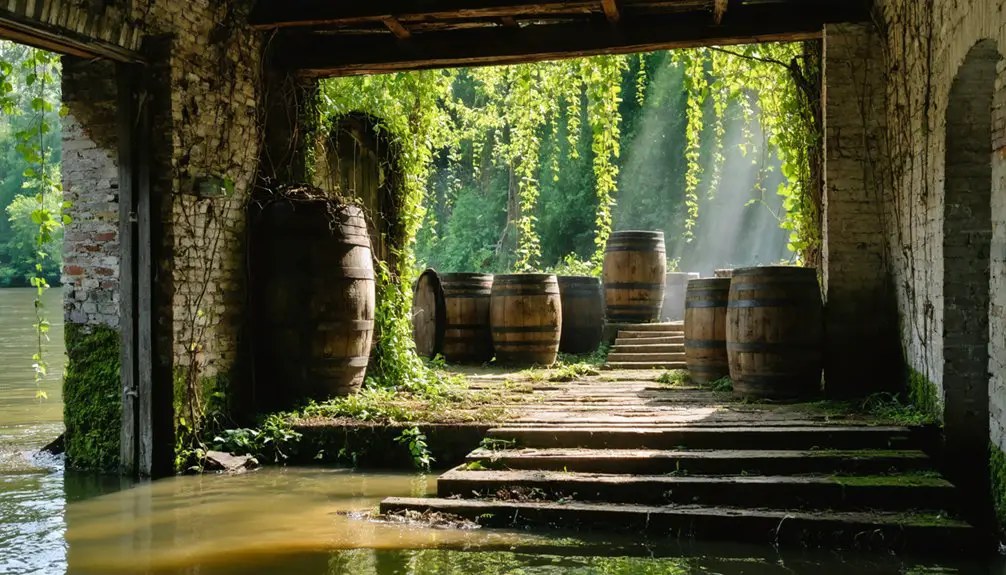
During Prohibition’s iron grip on America, Buffalo City transformed from a humble logging town into one of the East Coast’s most prolific moonshine producers. You would’ve found almost every family operating a still or helping with the trade, their moonshine craftsmanship producing the renowned “East Lake Whiskey” that outshined typical corn-based spirits. The land’s unique Blacklands soil quality contributed to the exceptional grains used in their spirits.
The underground networks they built were masterfully complex. You’d see boats like the *Hattie Creef* maneuvering Milltail Creek, while hidden stills dotted the swamplands. The town’s residents, consisting of African-American and Russian workers, played crucial roles in the distribution network.
Their rye-based whiskey reached speakeasies from Boston to the Carolinas, even attracting the likes of Al Capone. They’d cleverly time shipments around major events and tow bottles underwater to dodge revenuers.
Despite federal agents‘ best efforts, Buffalo City’s isolation and community solidarity kept the trade flowing well into the late 1930s.
Legacy and Modern-Day Remnants
Today, beneath the tangled vines and marshy waters of Alligator River National Wildlife Refuge, Buffalo City’s legacy persists in scattered remnants you’ll find if you know where to look.
Local preservation efforts keep this remarkable ghost town‘s memory alive through annual homecoming events at East Lake United Methodist Church, where descendants gather to share stories of their resilient ancestors.
While most structures have vanished into the swamp, you can still discover:
- Rusted rail tracks emerging from thick vegetation
- Scattered building debris marking where homes once stood
- A solitary road sign along U.S. 64, hinting at the town’s location
Historical documentation continues through oral histories and local archives, preserving Buffalo City’s unique story of diverse communities working together despite segregation, and its eventual transformation from bustling lumber town to moonshine haven.
Frequently Asked Questions
What Wildlife Species Posed the Greatest Threat to Buffalo City Residents?
You’d face dangerous wildlife encounters with alligators as your biggest predator threat, since they dominated the swampy waterways you needed for logging and travel, making daily activities particularly risky.
Did Any Descendants of Russian Immigrants Remain in Dare County?
Like scattered seeds in the wind, descendant connections vanished when Buffalo City declined. You won’t find clear evidence of Russian immigrant families remaining in Dare County, though their cultural heritage echoes in local history.
How Did Residents Receive Medical Care in Such an Isolated Location?
You’d rely on community-based care, traditional remedies, and visiting doctors since medical facilities were scarce. Healthcare access meant depending on neighbors, folk medicine, and occasional traveling physicians who braved the swamps.
What Happened to the Company-Built Homes After the Town Was Abandoned?
Like tears in rain, the abandoned company homes melted back into the swamp. You’d find their remains scattered beneath weeds and murky waters, with nature reclaiming what the sawmill town left behind.
Were There Any Documented Murders or Major Crimes in Buffalo City?
You won’t find documented murder mysteries or major crime history here. While moonshining was common, surviving records show no violent crimes, though the town’s remote location could’ve hidden some unreported incidents.
References
- https://en.wikipedia.org/wiki/Buffalo_City
- https://www.carolinadesigns.com/obx-guide/history/buffalo-city/
- https://www.northbeachsun.com/ghost-town-the-forgotten-story-of-dare-countys-buffalo-city/
- https://outerbankscoastallife.com/moonshine-capital/
- https://coastalreview.org/2021/10/history-for-lunch-to-feature-dares-abandoned-buffalo-city/
- https://scholar.lib.vt.edu/VA-news/VA-Pilot/issues/1994/vp941002/09300159.htm
- https://coastalreview.org/2024/04/author-documents-investment-fraud-involving-buffalo-city/
- https://www.houseofhighways.com/usa/southeast/north-carolina/buffalo-city
- https://coastalreview.org/2024/03/as-lumber-mill-declined-buffalo-city-loggers-made-shine/
- https://digitalcommons.buffalostate.edu/cgi/viewcontent.cgi?article=1059&context=history_theses
